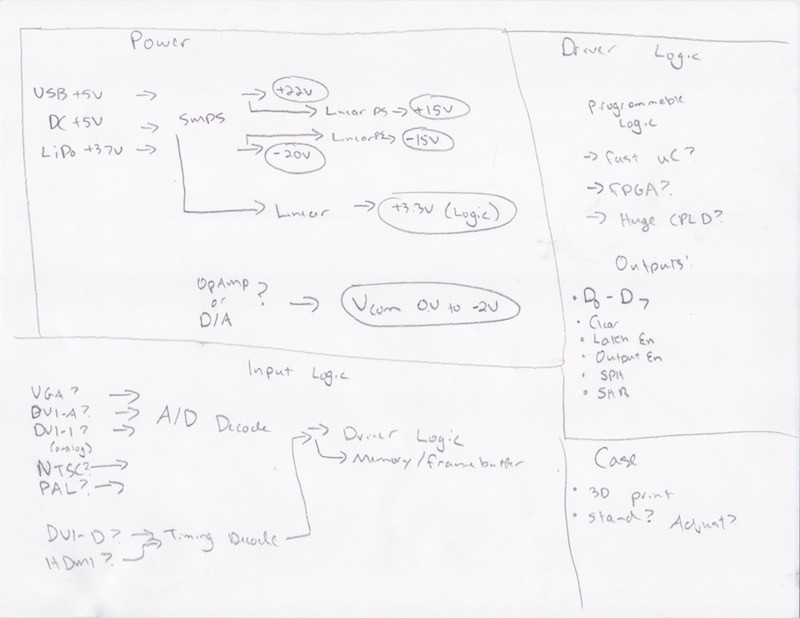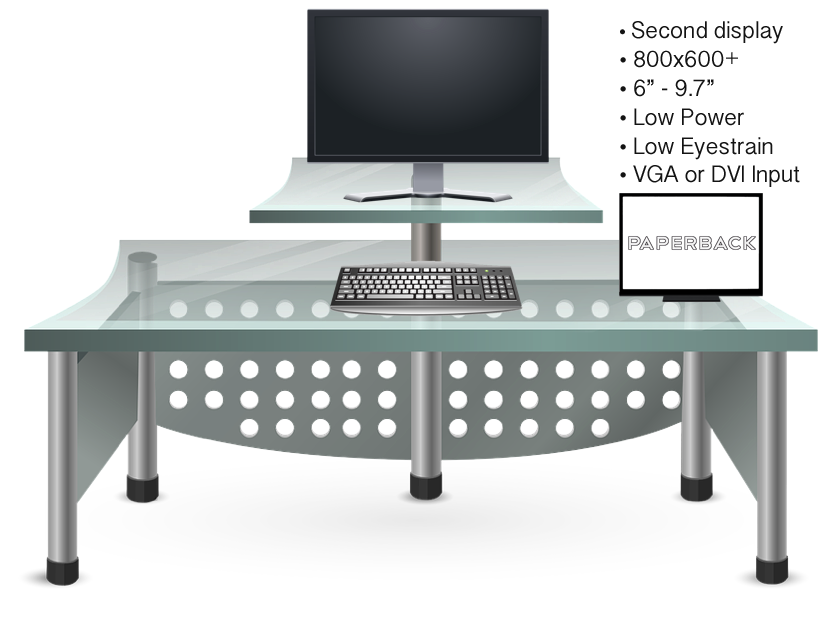-
E-Paper Plane: The View from 36,000 Feet
04/30/2017 at 22:37 • 3 comments![]()
While I would have preferred to start on a breadboard or protoboard, the fine pitch FFC on E-Paper displays pretty much rules that out. Instead, I started on the paper I've scanned in and dropped into the article above.
The way I see it, there are four parts of this project:
Power Supply
This actually might be the hardest part of the project - you need to generate a hodgepodge of random voltages to drive a screen like the ED060xxx or ED097xxx:
- +22V
- -20V
- +15V
- -15V
- 3.3V (Logic)
- Somewhere between 0 and -2.5V (a common/contrast/reference)
Great fun. My first shot will emulate some of the SMPS -> Linear regulator designs from other examples I've seen.
Driver Logic
The driver will both switch on and off the various power supplies and well as generate the data and latch combinations needed to get data onto the screen.
The lowest risk move here is probably to get a fast, high resourced microcontroller. The project examples I linked use the ESP8266 and various STM32xxx products here.
I think I lean a microcontroller with sufficient pins in case I do try to juice the refresh rates - we need about 15 outputs or so and I'd prefer not to push them through a GPIO expander. Maybe ESP32 here?
Input Logic
For my first effort, this will probably be Logic Level Asynchronous Serial. However, my final target, and what will motivate my entry is using a common display interface as input.
I think one of DVI-A or VGA would be the most fun, since it'd require an A/D converter and reversing some timings. DVD-D (or HDMI) would require just the second bit. Of course, most modern computers will output all of those, but analog display interfaces are on the way out and dongles/converters are hated. I'll think on the fun/product/'why not both?' aspects of this one.
If I'm particularly ambitious, maybe NTSC or PAL? Those protocols have everything mixed into the same signal, so it's add some fun analog to the project - separating color, sync, etc. I wouldn't count on this one though, even if I worked on that you'd still have pretty low resolutions. Also they're old. Give me some feedback below if you think they deserve their renaissance.
Case / Presentation
My 2015 entry didn't really need a case - it was just a video card on a PCB, haha. This time I'll need to take it seriously and take my first shot at what's sure to be some clumsy industrial design.
A stand for sure, but I'd love to log some frustrating hours with the 3D Printer. Any words of wisdom here? This category has the potential to dominate all others, haha.
For other parts of the presentation in general, I'll work up to them. As I get closer, that'll be writing up a guide, creating the video(s), packaging everything up - and possibly a web site and supporting documentation as well. Que sera, sera.
-
Answering the Hackaday Prize Prompts
04/30/2017 at 21:44 • 0 commentsTo organize my thoughts - and, of course, hit all the contest checkmarks - let's go through the list of Hackaday Prize prompts and answer them for PaperBack.
- Discuss the challenge the project addresses
PaperBack addresses two main challenges - eyestrain and power consumption.
For those of us who stare at various computer monitors too many hours a day, eyestrain can be a constant battle. We've learned that certain wavelengths of blue light can affect both your eye health and your sleep cycle. Even with some programs that can address the colors, backlights themselves can be fatiguing.
There was a large drop in average display power consumption when the world moved from CRT monitors to the ubiquitous LCD monitors most often used today. However, even with an LCD you're doing many refreshes, sometimes of static content. Additionally, the backlights in monitors require quite a bit of power.
- Discuss how the project will alleviate or solve the problem that the project addresses
An E-Paper display conveniently sidesteps the blue light issue - the targets I'm evaluating will support some shade of gray. For the type of content that E-Paper does well with - slowly moving graphics or high contrast static images and text - there's no need to stare at it on your main display. If you're like me and often have an API Reference or Datasheet open on a secondary monitor, maybe parking those on an e-paper display instead would help your eye fatigue at the end of the day.
E-Paper also requires the majority of its power when it is updating or refreshing. For static images, you could theoretically unplug the display and bring it elsewhere while retaining the image - for certain content, the power savings could be huge. Again, for an API Reference or Datasheet or some other rarely updating text or image you'd be saving power.
Of course, the biggest gain on that side would be in the aggregate. If enough people offloaded some content to an e-paper screen - with appropriate refresh rates - you'd be talking some significant savings.
- Discuss how the project might be world changing
I don't foresee the world moving away from the information economy. In the future, we will be using more and more computing power, and likely will still need a physical display to convey information (until those brain to computer interfaces are ready!).
If a different display technology is enough to save some power and reduce a bit of eyestrain, multiplied over the number of knowledge workers you'd see huge power savings... and less end-of-day headaches. In this case, the big win would be lower power and higher productivity.
- Publish at least one (1) image illustrating how the project might be used. This may be a sketch, schematic, flow chart, rendering, or other type of image.
![]()
Here is a clipart rendering of a secondary display. I've put some initial feature targets on it.
For the ubiquitous ED060SC4 // LB060S01, we get 6" diagonally and 800x600 resolution.
- Link to any repositories: https://github.com/dqydj/PaperBack_EPaper_Display
- Document all open-source licenses and permissions as well as any applicable third-party licenses/restrictions
Everything has an MIT or Berkeley or Apache like license, so if you see a part you like you can carve it off and work on it for your own projects.
-
E-Paper Design Resources & Feasibility
04/30/2017 at 16:21 • 1 commentWhile researching the product, I came across four excellent projects where people drove raw E-Paper displays:
- Petteri Aimonen's Essential Scrap E-Ink Project
- sprite_tm's WiFi E-Ink Display
- sapir's E-Ink Display Adapter
- Wenting Z.'s NekoCal E-Ink Calender
I'll stand on the shoulder of giants for this - my strategy will be to approach it in a few steps.
- Reproduce the results the others have had with an initial breakout.
- Work on the A/D or protocol decoding for some monitor interface
- VGA?
- DVI?
- HDMI? (Probably not, HDMI -> DVI adapters are common enough)
- Wrap it up in a decent looking package
Feasibility
Feasibility isn't an issue here, it seems that raw E-Paper displays have been driven enough times to give this a go without it being a large risk. By doing this in a modular fashion I should have a useful part even if, say, I only get through 2 out of 3 of my steps.
As for me? I do have graphics experience from past entries - although that was emitting graphics, not consuming them, haha. See my VGATonic 2015 Graphic Card Best Product entry as well as my 2014 initial project logs.
I'm hopeful I can get something going here.
-
Kicking around a Hackaday Prize Best Product Entry: "PaperBack"
04/30/2017 at 16:05 • 0 commentsAs soon as I saw that the 'Best Product' category was coming back to the Hackaday Prize, I got to thinking about what product I'd like to see on the market. I kicked around a few, but after polling my wife and some coworkers, it seems that there would be some demand for a desktop E-Paper display.
And yes, that's a product *I'd* love to have. From my perspective, I'd love to have a secondary monitor where I can park slow moving graphics or static text and images. Something small and readable would be perfect for API References and Datasheets - the sorts of things I'm staring at late at night, haha.
The Market Potential and Prior Art
I did some searching on what's out there in the marketplace.
The current gold standard for a secondary e-ink display is the Paperlike, a 13.3" E-Ink display. It is fully spec'd out with tons of features and display modes, a beautiful stand, and a reasonably sized team backing it. The current tradeoff is the pricetag: only a pre-order on a second batch is open right now, but I believe the cost is somewhere north of $1,000 (please correct me if that's wrong!).
Optionally, you could also get a developer kit and build out the driver yourself. One nice large-format example is Visionect's developer kits for 32" and 42" displays. That's a size where you could theoretically replace your primary monitor - but again, you're looking at a few thousand dollars.
As for competing technology, the cheapest somewhat comparable class of displays is reflective displays. Think your Game Boy Color or perhaps more recently the Pebble Smartwatch: color displays that perform well in direct sunlight.
Market Demand
While you don't necessarily need to validate your exact product versus the market (Henry Ford's possibly apocryphal "If I had asked people what they wanted, they would have said faster horses."), it's nice if you see some demand.
Well, you don't even need to leave Hacker News to see the demand. [1] [2] [3].
Also, again, I could use one. That's a factor I overweight, haha.
Would It Make a Good Product?
I think PaperBack would be a good entry.
My target specifications are modest:
- Use a ubiquitous 6" and/or 9.7" E-Paper display.
- Use VGA, DVI, HDMI or some common input as input.
- 800x600 or higher resolution.
- Some grayscale levels.
... perhaps even 9.7" is a bit small for a primary display (noticed that the smallest laptops you can generally buy are 10.1"?) but as a secondary display those sizes work well for some definitions of well.
PaperBack: A Desktop EPaper Monitor
EPaper monitor driven by either VGA or an Internet Connected ESP32.
 PK
PK
